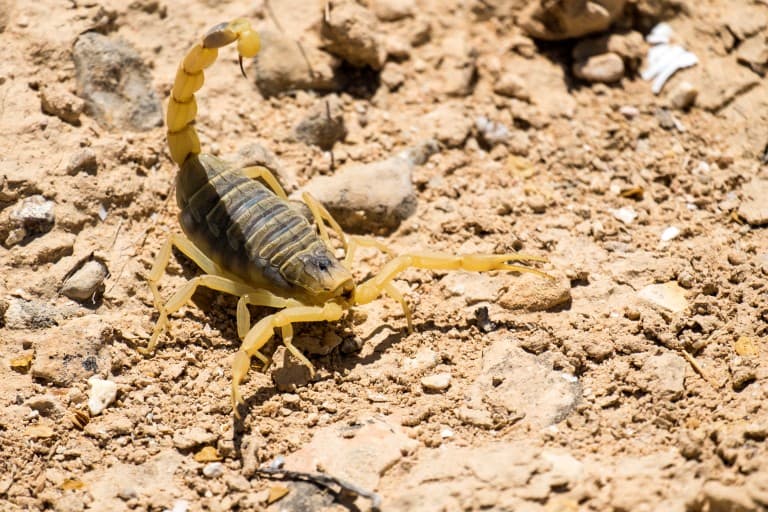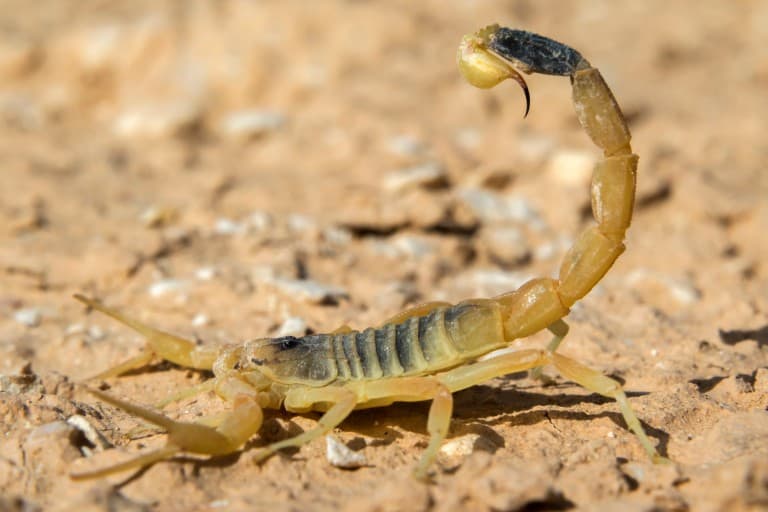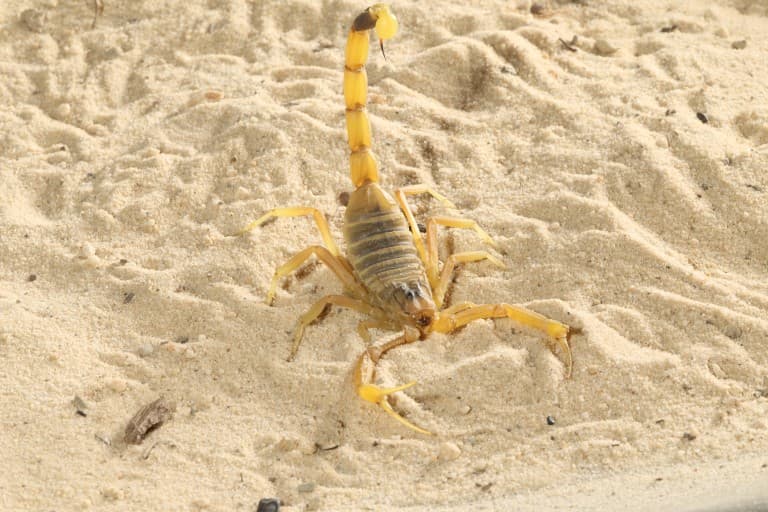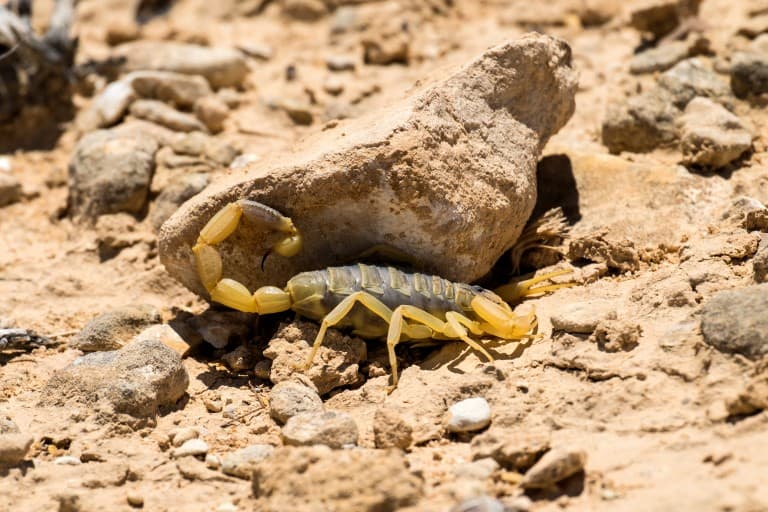Deathstalker Scorpion Profile
In the deserts of North Africa to the Middle East, there’s a scorpion that sounds like it was named by the US military.
Known for its potent and sometimes deadly venom, the Deathstalker scorpion is a scary little guy, but does he live up to the hype?
The deathstalker is a species of scorpion and is also referred to as the ‘Palestine yellow scorpion’, ‘Omdurman scorpion’ or ‘Naqab desert scorpion’.

Deathstalker Scorpion Facts Overview
| Habitat: | Desert and scrubland |
| Location: | North Africa and the Middle East |
| Lifespan: | Up to 25 years |
| Size: | 8cm (3 inch) long |
| Weight: | 3g |
| Colour: | Yellow/green |
| Diet: | Invertebrates |
| Predators: | Large mammals, centipedes, other scorpions |
| Top Speed: | Slow |
| No. of Species: | 1 |
| Conservation Status: | Not Listed (IUCN) |
Deathstalker scorpions are a strange greeny-yellow color with deceptively weedy arms and a sting in the tail.
That’s not a metaphor, either; they have one of the most dangerous scorpion venoms known.
Thankfully, that bar isn’t as high as it is with spiders and snakes, but it’s still best to avoid pushing your luck with one.
Though many do, as this venom also comes with a lot of potential for medical treatments, and has led some people to set up dodgy venom businesses to make a quick buck from a valuable resource that’s hard to come by.
Interesting Deathstalker Scorpion Facts
1. It’s one of the most dangerous scorpions
A commonly told rule of thumb with scorpions is that if it has small pincers and a large bulb on the tail, it’s likely dangerous. This isn’t always true, and shouldn’t be relied upon, but it does seem to ring true in a lot of cases.
Scorpions with large pincers lean more heavily on brute strength than venom to get their jobs done, and this usually means the scary-looking species like the Emperor or Giant Forest scorpions may look mean, but they can’t really harm you with a sting.
The Deathstalker, as the name suggests, is quite dangerous. Its tiny little pincers look feeble and suggest a powerful compensatory venom, of which it has plenty.
This venom can cause paralysis and respiratory failure and has been known to kill people, though it’s not usually lethal to a healthy adult. 1

2. But Scorpions aren’t usually all that dangerous
Despite looking incredibly primitive and dangerous – they’ve been around for over 350 million years – scorpions don’t pose much of a threat to adult humans in almost all cases.
Of the 2,500+ species, only about 25 of them have ever killed anyone, and most of these are survivable.
The Deathstalker is on that shortlist and has contributed to the 2,600 deaths reported each year from scorpion stings. However, the chance of death from a scorpion sting is less than 1% in untreated adults.
Allergic people are most at risk, as with any other sting.
3. Their venom seems to be designed for both mammals and invertebrates
This scorpion will primarily feed on invertebrates. It’s a small scorpion with spindly pincers, not really cut out for a battle with a large, warm-blooded creature.
However, there are two main toxins at play, one of which seems to work very effectively on invertebrate physiology, and the other particularly well on rat brains.
This suggests either a defensive component to their venom or the chance that the deathstalker will tackle a small rodent where necessary. 2
4. Their venom bulb acts as a thermometer
That big ball on the tip of the tail isn’t simply for carrying around the scorpion’s death juice. It also plays a role in the animal’s sensory array.
A scorpion has sensory hairs all over its body and different areas are responsible for different senses.
The legs have hairs to pick up on humidity levels, which is important to an animal who likes it humid. The pedipalps, or pincers, have hairs sensitive to touch, the mouthparts and pincers have hairs that can smell, and the venom bulb is covered in hairs that can tell the temperature.
These are all general senses that the scorpion will use to go about its day, but when it’s time to attach, they have a pair of simple eyes to identify and locate prey at close range. 3

5. They don’t like vinegar
Researchers know which hair does what because they spent a long time shaving scorpions to see what goes wrong.
Some of the experiments were kind of mean; they would starve the scorpion for 45 days and then give it food contaminated with salt to see if it can taste. To test heat sensitivity, they were poked with red-hot needles.
An experiment like this confirmed that one of the scorpion’s least-favourite smells is acetic acid – the acid found in vinegar. Despite the seemingly cruel approach, this is quite useful if you ever find yourself surrounded by deathstalkers in the supermarket.
6. They have been known to wear nail varnish
To figure out how well the scorpions could smell, the same researchers painted five of them with nail varnish on their pectines. These are feathered sensory organs on the underside of the scorpion.
In another test, they had their pincers painted. This was more than just a test to see how pretty they can get, by covering their sense organs and observing the scorpion’s behaviour, it’s possible to identify exactly which part of the body is responsible for what.
The results showed that the pectines don’t have as much sensitivity to smell as was previously thought and that the pincers play a role.
7. Their Venom is very useful (and expensive)
Aside from a cute pet that researchers can dress up for fun, deathstalkers have uses that are potentially valuable to medicine, too.
As with countless other highly venomous animals, this one has some interesting qualities to its venom that are being studied about the treatment of brain tumours and diabetes.
One of the toxins in this venom can be used as “tumour paint”; a marker to help scans pick out tumour cells in patients. 4

8. They’ve been reduced by venom collectors
Scorpion venom isn’t something that’s produced in large quantities, and the complexity of naturally-occurring venoms makes them difficult to synthesize. So, for scientists who want to use venom to develop a treatment, it has to be extracted from the animal directly.
This means milking scorpions. Lots and lots of scorpions! And since so little is produced and the job is so dangerous, this venom gets very expensive.
A wave of scorpion hunters, inspired by the idea that they could strike it rich by selling venom, contributed to a sudden rise in scam industries around the deathstalker venom, selling low-grade and impure venoms.
Thankfully, the deathstalker is still a common scorpion and doesn’t look to be on the way out just yet. 5
Deathstalker Scorpion Fact-File Summary
Scientific Classification
| Kingdom: | Animalia |
| Phylum: | Arthropoda |
| Class: | Arachnida |
| Order: | Scorpiones |
| Family: | Buthidae |
| Genus: | Leiurus |
| Species: | Leiurus Quinquestriatus |
Fact Sources & References
- SHAUL SOFER (1988), “RESPIRATORY FAILURE IN CHILDREN FOLLOWING ENVENOMATION BY THE SCORPION LEIURUS QUINQUESTRIATUS: HEMODYNAMIC AND NEUROLOGICAL ASPECTS”, Sci Hub.
- Pierre Sautiere (1998), “NEW TOXINS ACTING ON SODIUM CHANNELS FROM THE SCORPION LEIURUS QUINQUESTRIATUS HEBRAEUS SUGGEST A CLUE TO MAMMALIAN VS INSECT SELECTIVITY”, DeÂpartement d’IngeÂnierie et d’Etudes des ProteÂines, Bat. 152 – C.E. Saclay, 91191 Gif-sur-Yvette Cedex, France.
- Faysal Tageldin Abushama (1964), “On the behaviour and sensory physiology of the scorpion Leiurus quinquestriatus”, Science Direct.
- “One Doctor’s Quest to Save People by Injecting Them With Scorpion Venom”, Wired.
- Richard Pallardy (2021), “What’s So Special About the Deathstalker Scorpion?”, Discover Magazine.
